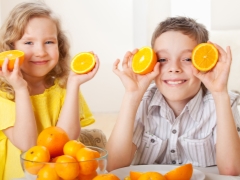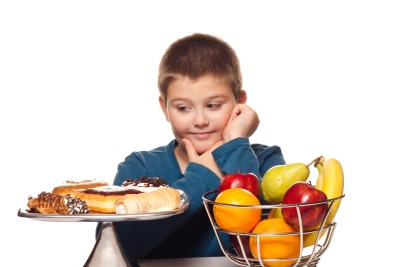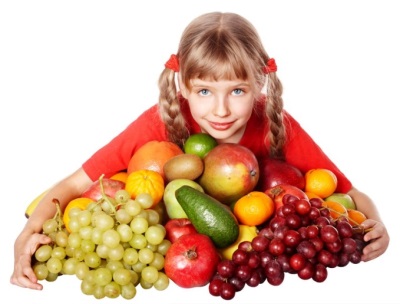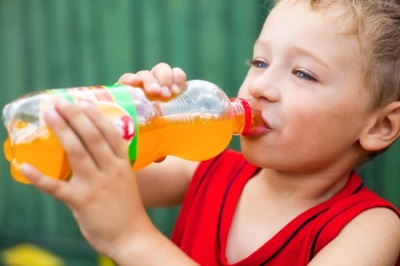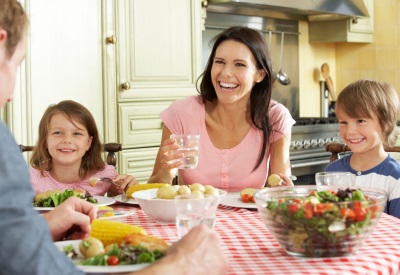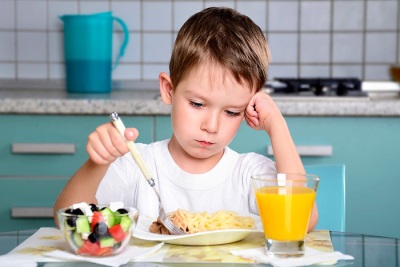Proper nutrition of the student: the basics of the diet and the principles of the menu
When a child begins to go to school, the requirements for his diet change, because students have quite large psychological and mental stress. In addition, many children attend sports clubs. At the same time, the organism continues to grow actively, therefore, the nutritional needs of the child of school age should always be given sufficient attention. Let's find out what products children over the age of 7 need, how much a schoolchild should use them every day and how best to build a menu for a child of this age.
Principles of healthy eating
A child over 7 years old needs a balanced healthy diet no less than young children.
The main nutritional nuances of children of this age are as follows:
- During the day, so many calories should come from food to cover the energy costs of the child.
- The diet of the student should be balanced for indispensable and replaceable nutrients. To do this, it is recommended to diversify it as much as possible.
- It is important to take into account the individual characteristics of the child’s body.
- At least 60% of the proteins in the diet of a schoolchild should come from animal products.
- The amount of carbohydrates obtained from food for a student should be 4 times more than the amount of protein or the amount of fat.
- Fast carbohydrates presented in the child's menu sweets should be up to 10-20% of all carbohydrates.
- It is important to have a regimen of meals for the child to eat regularly.
- The diet of the student should include bread, potatoes, cereals. Flour products for the child should be cooked on coarse flour.
- Once or twice a week the child should eat fish. Also, at least once in the weekly menu of the student should be red meat.
- Legumes are recommended for children of this age 1-2 times a week.
- Daily in the diet of the child should be five servings of vegetables and fruits. Orange, apple, banana or other medium fruit, 10-15 berries or grapes, two small fruits (apricot, plums), 50 g of vegetable salad, a glass of juice (only natural juice is counted), a tablespoon of dried fruits, 3 tbsp. l boiled vegetables.
- Daily baby should eat dairy products. Three servings are recommended, one of which may be 30 g of cheese, a glass of milk, one yogurt.
- Sweets and fatty foods are permissible in a student's diet, unless they replace healthy and healthy food, as there are very few vitamins and minerals in cookies, cakes, waffles, french fries and other such foods.
- It is necessary to minimize the intake of synthetic food additives, as well as spices.
The needs of the child-student
6-9 years | 10-13 years | 14-17 years old | |
The need for energy (in kcal per 1 kg of weight) | 80 (on average 2300 kcal per day) | 75 (on average 2500-2700 kcal per day) | 65 (on average 2600-3000 kcal per day) |
Protein Requirement (g per day) | 80-90 | 90-100 | 100-110 |
Fat Requirement (g per day) | 80 | 85-95 | 90-100 |
The need for carbohydrates (g per day) | 320-260 | 360-400 | 400-440 |
Cottage cheese | 50 g | 50 g | 60 g |
Meat | 140g | 170g | 200-220 g |
Milk and dairy products | 500 ml | 500 ml | 500-600 ml |
Eggs | 1 piece | 1 piece | 1 piece |
10-15 g | 10-15 g | 10-15 g | |
A fish | 50 g | 50 g | 60-70 g |
Sugar and sweets | 70 g | 80 g | 80-100 g |
Bakery products | 225 g | 300 g | 300-400 g |
Rye bread | 75g | 100 g | 100-150 g |
Flour | 25 g | 30 g | 30-35 g |
Cereals, pasta and legumes | 35-45 g | 50 g | 50-60 g |
Vegetables | 275-300 g | 300 g | 320-350 g |
Potatoes | 200 g | 250 g | 250-300 g |
Raw fruit | 150-300 g | 150-300 g | 150-300 g |
Dried fruit | 15 g | 20 g | 20-25 g |
Butter | 25 g | 30 g | 30-40 g |
Vegetable oil | 10 g | 15 g | 15-20 g |
Diet
The mode of eating a child attending school is affected by a shift in learning. If the child is studying in the first shift, then he:
- Breakfast at home at about 7-8 hours.
- Snacks at school in 10-11 hours.
- He dines at home or at school at 13-14 hours.
- Dines at home at about 19 o'clock.
The child, whose training occurs in the second shift:
- Breakfast at home at 8-9 o'clock.
- He dines at home before going to school, at 12-13 o'clock.
- Snacks at school at 16-17 hours.
- He dines at home at about 20 o'clock.
Breakfast and lunch should be the most energetically valuable and provide a total of about 60% of the daily calories. A child should have dinner a maximum of two hours before he goes to bed.
What are the best ways to cook?
Schoolchildren can prepare food in any way, but they still do not recommend to get involved in frying, especially if the child has low activity or has a tendency to recruit subcutaneous fat. The most optimal types of cooking for children are quenching, baking and boiling.
What foods need to be limited in the diet?
Try to limit the following products in the child’s menu:
- Sugar and white bread - with excessive consumption, they cause weight gain.
- Products that have food additives (dyes, preservatives, and others).
- Margarine.
- Non-seasonal fruits and vegetables.
- Sweet soda.
- Caffeinated products.
- Mayonnaise, ketchup and other industrial sauces.
- Spicy dishes.
- Fast food.
- Smoked sausages.
- Mushrooms
- Dishes, which are cooked in deep fat.
- Juices in packages.
- Chewing gum and candy.
What give liquids?
The best drinks for school-age children are water and milk. The disadvantages of juices are high sugar content and high acidity, so they should either be given during meals or diluted with water.
The total amount of fluid a student must consume per day is influenced by his activity, nutrition, and weather. If the weather is hot and the child’s activity is increased, give the child more water or milk.
Carbonated drinks and caffeinated products are not recommended in the early school years. Older students give such drinks acceptable, but not during meals, as iron absorption deteriorates due to caffeine.
How to make a menu?
- For breakfast, it is advised to give 300 g of the main dish, for example, porridge, casseroles, cheesecakes, pasta, muesli. To him, offer 200 ml of drink - tea, cocoa, chicory.
- For lunch, it is advised to eat a vegetable salad or other snack in an amount up to 100 g, a first dish in a volume of up to 300 ml, a second dish in an amount up to 300 g (it includes meat or fish, and also a side dish) and a drink in a volume of up to 200 ml.
- Lunch can include baked or fresh fruit, tea, kefir, milk or other drink with cookies or homemade cakes. The recommended volume of beverage for snack is 200 ml, the amount of fruit is 100 g, and baking is up to 100 g.
- The last meal includes 300 g of the main dish and 200 ml of the drink. At dinner, it is worth making a child a light protein dish, for example, from cottage cheese. Also for dinner, good dishes from potatoes and other vegetables, cereals, egg dishes or fish.
- For each meal, you can add bread in a daily amount of up to 150 g of wheat bread and up to 75 g of rye.
First of all, it is necessary to take into account the change in which the child learns, since this affects his meals. In addition, it is recommended to prepare a ration not for one day, but for the whole week, so that the dishes do not repeat and all the necessary products are present in the weekly menu.
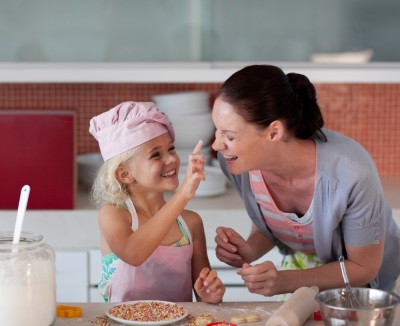
An example of the correct menu for the week
Day of the week | Breakfast | Dinner | Afternoon tea | Dinner |
Monday | Cheesecakes with apples and sour cream (300 g) Tea (200 ml) Sandwich (100 g) | Cabbage and carrot salad (100 g) Borsch (300 ml) Rabbit cutlet (100 g) Mashed potatoes (200 g) Compote of dried pears and prunes (200 ml) Bread (75g) | Kefir (200 ml) Orange (100 g) Cookies (50 g) | Omelet with green peas (200 g) Rosehip Infusion (200 ml) Bread (75g) |
Tuesday | Rice milk porridge with raisins (300 g) Cocoa (200 ml) Sandwich (100 g) | Beetroot Salad (100 g) Broth with egg (300 ml) Beef chops (100 g) Braised cabbage with zucchini (200 g) Apple Juice (200 ml) Bread (75g) | Milk (200 ml) Bun with curd (100 g) Apple fresh (100 g) | Potato zrazy with meat (300 g) Tea with honey (200 ml) Bread (75g) |
Wednesday | Omelet with cheese (200 g) Fish Cutlet (100 g) Tea (200 ml) Sandwich (100 g) | Eggplant caviar (100 g) Potato soup with dumplings (300 ml) Stewed Liver (100 g) Corn porridge (200 g) Fruit jelly (200 ml) Bread (75g) | Kefir (200 ml) Baked Apple (100 g) Oat cookies (50g) | Pancakes with cottage cheese and raisins (300 g) Milk (200 ml) Bread (75g) |
Thursday | Buckwheat milk porridge (300 g) Chicory (200 ml) Sandwich (100 g) | Radish and Egg Salad (100 g) Home pickle (300 ml) Chicken Cutlet (100 g) Boiled cauliflower (200 g) Pomegranate juice (200 ml) Bread (75g) | Milk (200 ml) Apple Pie (100 g) | Casserole of vermicelli and cottage cheese (300 g) Tea with jam (200 ml) Bread (75g) |
Friday | Cottage cheese pancakes with honey (300 g) Tea with milk (200 ml) Sandwich (100 g) | Apple and carrot salad with sour cream (100 g) Noodle broth (300 ml) Beef Stroganoff with steamed vegetables (300 g) Compote of grapes and apples (200 ml) Bread (75g) | Fruit Jelly (100 g) Sour milk (200 ml) Biscuit (100 g) | Rice pudding with raisins and dried apricots (300 g) Kefir (200 ml) Bread (75g) |
Saturday | Oatmeal with berries (300 g) Cocoa (200 ml) Sandwich (100 g) | Squash caviar (100 g) Beetroot (300 ml) Baked fish (100 g) Boiled potatoes with green peas (200 g) Peach juice (200 ml) Bread (75g) | Milk Jelly (100 g) Tea (200 ml) Bun with raisin (100 g) | Omelet with tomatoes (200 g) Chicory with milk (200 ml) Bread (75g) |
Sunday | Millet porridge with pumpkin and carrots (300 g) Tea with honey (200 ml) Sandwich (100 g) | Cucumber salad and tomato (100 g) Vegetable puree soup (300 ml) Squid rolls (100 g) Boiled macaroni (200 g) Tomato juice (200 ml) Bread (75g) | Kefir (200 ml) Pear (100 g) Cottage Cheese Cookies (50 g) | Potato patties with sour cream (300 g) Milk (200 ml) Bread (75g) |
Some useful recipes
Fish zrazy with cottage cheese
Slices of fish fillet (250 g) a little beat off and salt. Cottage cheese (25 g), mix with herbs and salt. Put a little cottage cheese on each piece of fish fillet, roll up a roll and roll in flour, and then in a beaten egg. Fry a little in the pan, and then put zrazy in the oven to bring them to readiness.
Rassolnik
Peel, chop, and then pass one carrot and one onion until they turn yellow. Add tomato paste (2 teaspoons), cook another 2-3 minutes, then remove from heat. Peel three potatoes, cut into slices and boil until half cooked. Add to the potatoes the browned vegetables, cut into small cubes, one pickled cucumber and a pinch of salt. Boil the soup until cooked over low heat, and before serving, add a teaspoon of sour cream to each plate and sprinkle with chopped greens.
Meat fill balls
Take a pound of meat with bones and boil, adding a quarter of celery root and a quarter of parsley root to the water. Pour the broth into a separate container, and chop the meat in a meat grinder together with the onion fried in oil. Add to the resulting minced sour cream (2 tbsp. L.), Pounded butter (3 tbsp. L.), Pepper and salt. Make small balls. To the broth add pre-prepared gelatin (10 g). Fill the balls with broth and leave to freeze. You can add sliced boiled carrots and boiled chicken eggs to the balls.
Possible problems
In feeding the child of school age there are various problems with which parents should be able to cope in time.
What if the child does not eat the foods he needs?
A child over seven years old has already developed tastes, so he can refuse certain products and insist that he eat them, despite disgust and rejection, is not worth it. So eating behavior can be further aggravated. Parents should try to cook unloved foods in different ways, perhaps one of them will please the child.
Otherwise, it is not necessary to insist on eating any food if the child’s food can be called diverse - if there is at least 1 type of dairy products, 1 type of vegetables, 1 variant of meat or fish, 1 type of fruit and some dish in his diet from cereals. These product groups must be in the children's menu.
Quick snacks in the school cafeteria
For younger students in schools, breakfast and sometimes a hot lunch are usually provided. If a student buys pastries in the dining room, parents should make sure that breakfast before school and lunch immediately after returning home are nutritious and made from healthy products. Also, give your child a useful alternative to school buns, such as fruit, yogurt, or homemade cakes.
Lack of appetite due to stress
Many students experience serious psychological stress during training, which affects appetite. Parents should carefully monitor the child and respond in time to a situation where stress has become a cause of decreased appetite.
It is important to think about the rest of the child after returning home and on the weekend, giving him the opportunity to switch attention and do what he likes. Hobbies, especially those related to physical activity, such as hiking, rollerblading, cycling, and various sports sections help relieve stress.
How to understand that lack of appetite is a symptom of the disease?
The fact that reduced appetite can be a sign of a disease will be indicated by such factors:
- The child loses weight, it is inactive and sluggish.
- He had problems with the chair.
- The child is pale, his skin is very dry, the condition of his hair and nails has deteriorated.
- The child complains of the periodic appearance of pain in the abdomen.
- A rash appeared on the skin.
Binge eating
Excessive consumption of food leads to fullness in children, the cause of which most often is heredity and lifestyle. A full child doctor recommends changing the diet, but parents may encounter difficulties. For example, in order not to seduce a child with sweets, they will have to be abandoned by the whole family. In addition, the child will assume that the prohibitions are unfair, and can feast on forbidden dishes in secret.
Best of all, if a complete child talks to a nutritionist alone, then he will more easily accept the advice of the doctor and feel more responsible. According to experts, overeating is often a sign of psychological distress, for example, loneliness. Therefore, it makes sense to go with the child and to the psychologist.
Tips
- To share a schoolboy with the principles of healthy eating with parents will help meals, provided that the whole family eats properly. Tell your child more about the health benefits of foods and the importance of nutrition.
- If a child takes food to school, offer sandwiches with cheese, baked meat, a pie, a curd bun, bagel, casserole, fruit, cheesecakes, and yogurt. Think about how to pack food and how the child can eat it. To do this, buy special containers and wrap sandwiches in foil.
- Do not give children full fat-free foods, but give preference to low-fat dairy products.
